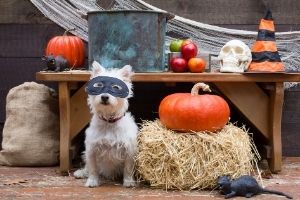July 4th gets a bad rap for being the worst holiday for pets, but Halloween brings some concerns of its own. We’re not trying to be the Debbie Downers of the season (you’re welcome for the costume idea, BTW) but, as veterinarians, our job is to keep your fur friends safe. So as you’re carving those pumpkins and getting your wee witches and warlocks ready for the big day, set aside some time to make sure you’re keeping your furry felines and hairy hounds safe, too.

Keep Your Pets Indoors Far From the Frights
Whether you have trick-or-treaters stop by your home or you opt for a small family get-together, it’s best to keep pets inside during the evening of Halloween. Pets can become easily startled during all the commotion, especially when they are not used to strangers visiting the home. Not only that, but some pets might try to bolt out when opening the door to trick-or-treaters and no one wants to experience having their pet become lost. Microchipping (more on that later) helps when it comes to lost pets but the best thing is to keep them in an area where bolting every time the door opens isn’t even an option.

Don’t Force a Costume On Your Pet
We get it. Anything for the ‘Gram, right? We understand that dressing up your pet in a costume can be a fun way to have them participate in the Halloween hoopla. However, it’s important to keep in mind that costumes are not for all pets and they can actually cause distress for the dogs and cats that aren’t comfortable wearing them.
If you decide to put your pet in a costume, make sure that the costume fits them properly and doesn’t restrict their movement or interfere with their sight, hearing, breathing, or opening their mouth. Make sure there are no costume pieces that can easily be chewed off or become choking hazards. Additionally, never leave your pet unattended while they are wearing a costume. If your pet is obviously stressed out and not comfortable with wearing a costume, take it off of them immediately. Nothing is worth causing unnecessary discomfort to your precious pets.

Don’t Forget Those IDs!
Whether they are dressed up or not, your pet should have proper identification on them at all times. During the commotion of trick-or-treaters or having a get-together, your home could quickly become a House of Horrors if your pet happens to escape outside and become lost.
The most common form of identification is a collar with a name tag containing information such as your pet’s name, your name, and a current phone number. Keep in mind that collars are not fool-proof, as they can come off your pet while they are wandering around. This is particularly true of cat collars, as they are designed to break away so they don’t cause the cat to choke if they get caught on a bush or something else.
Microchipping is a great form of permanent identification that will last for the lifetime of your pet. A microchip is a small chip that is inserted under your pet’s skin via injection. This process is absolutely safe for both cats and dogs. If your pet is found by someone and taken to an animal shelter or pet hospital, the microchip can be scanned to obtain your pet’s microchip number, and they will be able to contact the microchip company to get your contact information. From there, you will be notified and be able to be reunited with your beloved pet.

Tricks Are Fine, But Skip the Treats!
It’s not quite Halloween without buckets of candy around the house. While the family is indulging in Halloween treats, just be sure that you lil’ minion or butterfly don’t help themselves to your candy stash. Chocolates, especially dark chocolate and baking chocolate, are extremely toxic to pets and can cause serious risk to their health.
- Vomiting
- Diarrhea
- Rapid breathing
- Increased heart rate
- Seizures
Additionally, sugar-free candies containing the sugar substitute, Xylitol, making these especially harmful to pets. Ingesting them can lead to liver failure in dogs. If your pet happens to ingest something they shouldn’t have, be sure to contact your veterinarian immediately.
The best practice is to set aside a quiet, escape-proof space or room for your pet to stay during the evening. Make sure the area is comfortable for your pet and you can even have music playing or have the television on to help muffle the sounds of the outside commotion. If you’d like other tips on how to make this Howl-oween a scream but not a pet disaster, please give us a call!

